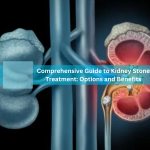Kidney stones can be incredibly painful and disruptive to daily life. Fortunately, advancements in medical technology have provided new, effective methods for their removal. This blog post will explore the latest technology for kidney stone removal, offering valuable insights into how these innovations can benefit patients.
Understanding Kidney Stones
What Are Kidney Stones?
Kidney stones are hard deposits made of minerals and salts that form inside the kidneys. They can cause severe pain and discomfort, especially when they move through the urinary tract. The primary types of kidney stones include calcium stones, uric acid stones, struvite stones, and cystine stones.
Symptoms of Kidney Stones
Common symptoms of kidney stones include sharp pain in the back or side, blood in the urine, frequent urination, and nausea. If you experience any of these symptoms, it is essential to seek medical attention promptly.
Traditional Treatments for Kidney Stones
Medication and Hydration
In many cases, small kidney stones can be treated with medication and increased fluid intake. Pain relievers and medications that relax the muscles in the ureter can help pass the stones more easily.
Extracorporeal Shock Wave Lithotripsy (ESWL)
ESWL is a non-invasive procedure that uses shock waves to break kidney stones into smaller fragments, which can then be passed naturally through the urine. While effective, this method can sometimes require multiple sessions.
Latest Technology for Kidney Stone Removal
Ureteroscopy with Laser Lithotripsy
What is Ureteroscopy?
Ureteroscopy involves the use of a thin, flexible scope called a ureteroscope, which is inserted through the urinary tract to reach the kidney stones. Once the stones are located, a laser is used to break them into smaller pieces. This minimally invasive procedure is highly effective for removing stones located in the ureter or kidney.
Benefits of Laser Lithotripsy
Laser lithotripsy offers several benefits, including high precision, reduced recovery time, and minimal discomfort. The laser can accurately target and fragment the stones, reducing the risk of leaving behind residual fragments.
Retrograde Intrarenal Surgery (RIRS)
Understanding RIRS
RIRS is a minimally invasive procedure used to treat stones within the kidney. It involves the use of a flexible ureteroscope, which is inserted through the urethra and bladder to access the kidney. A laser is then used to break the stones into smaller pieces.
Advantages of RIRS
RIRS offers numerous advantages, such as minimal incisions, reduced risk of complications, and a faster recovery time. It is particularly useful for treating larger stones or those located in hard-to-reach areas of the kidney.
Percutaneous Nephrolithotomy (PCNL)
What is PCNL?
PCNL is a surgical procedure used to remove large or complex kidney stones. It involves making a small incision in the back and inserting a nephroscope directly into the kidney to remove the stones. This method is highly effective for treating large stones that cannot be broken down using other techniques.
Benefits of PCNL
PCNL offers the benefit of removing large stones in a single procedure, reducing the need for multiple treatments. It is particularly useful for patients with complex stone formations or those who have not responded to other treatments.
Robotic-Assisted Surgery
Innovations in Robotics
Robotic-assisted surgery is an emerging technology in the field of urology. It involves the use of robotic systems to assist surgeons in performing precise and minimally invasive procedures. This technology offers enhanced precision, flexibility, and control during surgery.
Benefits of Robotic Surgery for Kidney Stones
Robotic-assisted surgery provides several benefits, including reduced pain, shorter hospital stays, and faster recovery times. The high precision of robotic systems also reduces the risk of complications and improves overall surgical outcomes.
Future Technologies
Advancements in Imaging
Advancements in imaging technology, such as 3D imaging and real-time navigation systems, are improving the accuracy and effectiveness of kidney stone treatments. These technologies allow for better visualization of the stones and surrounding structures, enhancing the precision of surgical procedures.
Nanotechnology and Drug Delivery
Nanotechnology is an exciting area of research that holds promise for future kidney stone treatments. Nanoparticles can be used to deliver medications directly to the site of the stones, improving the effectiveness of treatment and reducing side effects.
Conclusion
The latest technology for kidney stone removal offers a range of benefits, from minimally invasive procedures to enhanced precision and faster recovery times. Whether you are dealing with small stones or complex formations, these advancements provide effective and patient-friendly options for treatment. By staying informed about the latest innovations, you can make the best decisions for your health and well-being.
Engaging FAQs
Percutaneous Nephrolithotomy (PCNL) is considered the most effective treatment for large kidney stones. It involves a surgical procedure to remove the stones directly from the kidney.
Laser lithotripsy is generally well-tolerated and causes minimal discomfort. Any pain can typically be managed with pain relievers prescribed by your doctor.
Recovery from RIRS is usually quick, with most patients resuming normal activities within a few days to a week.
While robotic-assisted surgery is generally safe, there are potential risks, including infection, bleeding, and complications related to anesthesia. However, these risks are relatively low.
Yes, kidney stones can recur after treatment. It is important to follow preventive measures, such as staying hydrated and making dietary changes, to reduce the risk of recurrence. Regular follow-ups with your healthcare provider are also recommended.





